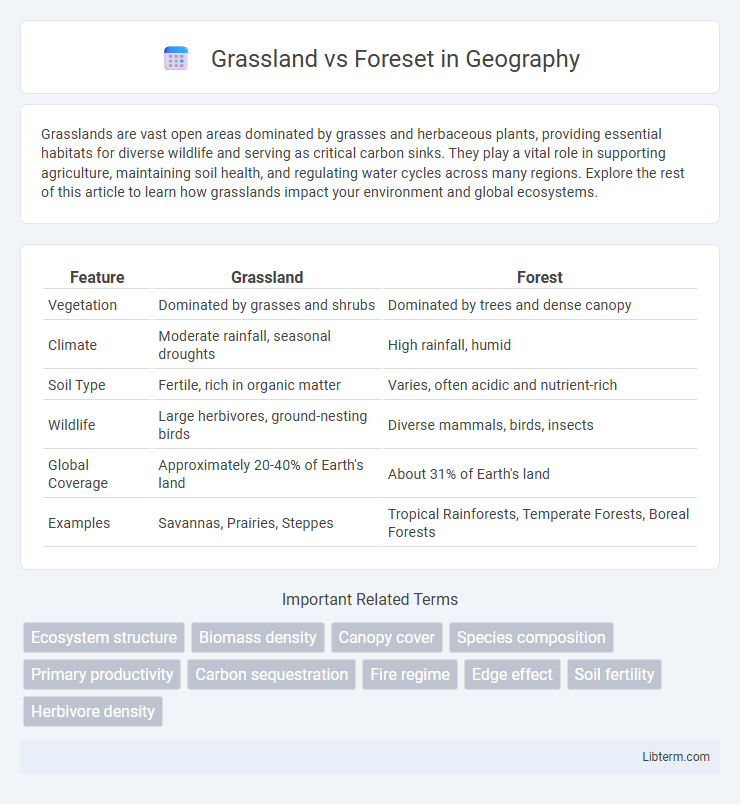Grasslands are vast open areas dominated by grasses and herbaceous plants, providing essential habitats for diverse wildlife and serving as critical carbon sinks. They play a vital role in supporting agriculture, maintaining soil health, and regulating water cycles across many regions. Explore the rest of this article to learn how grasslands impact your environment and global ecosystems.
Table of Comparison
| Feature | Grassland | Forest |
|---|---|---|
| Vegetation | Dominated by grasses and shrubs | Dominated by trees and dense canopy |
| Climate | Moderate rainfall, seasonal droughts | High rainfall, humid |
| Soil Type | Fertile, rich in organic matter | Varies, often acidic and nutrient-rich |
| Wildlife | Large herbivores, ground-nesting birds | Diverse mammals, birds, insects |
| Global Coverage | Approximately 20-40% of Earth's land | About 31% of Earth's land |
| Examples | Savannas, Prairies, Steppes | Tropical Rainforests, Temperate Forests, Boreal Forests |
Introduction: Understanding Grasslands and Forests
Grasslands and forests are distinct ecosystems characterized by their vegetation and climate conditions. Grasslands primarily consist of grasses and herbaceous plants, supporting herbivores and adapted to moderate rainfall and periodic droughts. Forests contain dense tree cover, high biodiversity, and thrive in areas with consistent moisture levels, playing a crucial role in carbon sequestration and habitat provision.
Key Characteristics of Grasslands
Grasslands are characterized by vast open spaces dominated by grasses, with few trees and shrubs, thriving in regions with moderate rainfall between 250 to 750 millimeters annually. These ecosystems support herbivores like bison and zebras, adapted to grazing on the dense ground cover, and experience distinct seasonal temperature variations. Unlike forests, grasslands have nutrient-rich soils ideal for agriculture but are more susceptible to fires and periodic droughts, which help maintain their ecological balance.
Key Characteristics of Forests
Forests are characterized by dense tree coverage, rich biodiversity, and a multi-layered canopy structure supporting various flora and fauna. They play a crucial role in carbon sequestration, oxygen production, and maintaining global climate stability. Unlike grasslands dominated by grasses and herbaceous plants, forests have complex ecosystems with significant biomass and nutrient cycling.
Climate Differences Between Grassland and Forest Biomes
Grassland biomes experience more extreme temperature variations with hot summers and cold winters, while forest biomes generally have more moderate and stable temperatures due to denser vegetation cover. Precipitation levels in forests are significantly higher, often exceeding 75 cm annually, supporting dense tree growth, whereas grasslands receive between 25 to 75 cm, favoring grasses and shrubs adapted to drier conditions. These climatic differences dictate the distinct flora and fauna, with forests supporting diverse, moisture-dependent species and grasslands hosting drought-resistant plants and grazing animals.
Biodiversity: Flora and Fauna Comparisons
Grasslands support a diverse array of grasses, herbaceous plants, and scattered shrubs, creating habitat for large grazing mammals such as bison and antelope, as well as insect species including grasshoppers and butterflies. Forests exhibit higher plant species diversity with multiple canopy layers, including tall trees, understory shrubs, and groundcover, fostering habitats for a wide range of fauna including birds, mammals like deer and bears, and numerous amphibians and insects. The structural complexity of forests contributes to greater overall biodiversity compared to grasslands, which maintain specialized species adapted to open, sunlit environments.
Ecosystem Services Provided by Grasslands vs Forests
Grasslands provide essential ecosystem services such as carbon sequestration, soil fertility enhancement, and habitat for diverse herbivores and pollinators critical for agricultural productivity. Forests contribute significantly to climate regulation through carbon storage, water cycle stabilization, and provisioning of timber and non-timber products supporting biodiversity conservation. Both ecosystems play vital roles in supporting global ecological balance, but grasslands excel in supporting grazing systems and soil health, while forests are key for oxygen production and complex habitat structures.
Human Impact and Land Use Patterns
Grasslands face significant alteration from agricultural expansion and livestock grazing, leading to habitat fragmentation and soil degradation. Forests experience deforestation primarily driven by logging, urbanization, and industrial development, resulting in biodiversity loss and carbon storage reduction. Both ecosystems are heavily influenced by human land use patterns that prioritize economic activities over ecological balance.
Carbon Sequestration: Grasslands vs Forests
Grasslands store significant amounts of carbon primarily in their extensive root systems and soil, often surpassing forests in below-ground carbon storage. Forests capture large quantities of carbon through biomass in trees and leaf litter, contributing substantially to atmospheric carbon reduction. Both ecosystems play crucial roles in global carbon sequestration, with grasslands offering long-term soil carbon stability and forests providing rapid carbon uptake.
Conservation Challenges and Strategies
Grasslands face conservation challenges including habitat fragmentation, overgrazing, and invasive species that reduce biodiversity and carbon storage capacity, while forests grapple with illegal logging, deforestation, and climate-induced pests that threaten ecosystem stability and wildlife habitats. Effective strategies for grassland conservation emphasize sustainable grazing practices, restoration of native plant species, and protection from agricultural expansion, whereas forest conservation prioritizes reforestation, enforcement of logging regulations, and the establishment of protected areas. Both ecosystems benefit from community-based management, monitoring using remote sensing technology, and climate adaptation measures to enhance resilience.
Conclusion: Balancing Grassland and Forest Preservation
Balancing grassland and forest preservation requires prioritizing biodiversity conservation, ecosystem services, and climate regulation provided by both habitats. Integrating sustainable land management practices supports habitat connectivity and resilience against environmental change. Effective policies must address human activity impacts while promoting restoration and protection efforts to maintain ecological equilibrium.
Grassland Infographic

 libterm.com
libterm.com